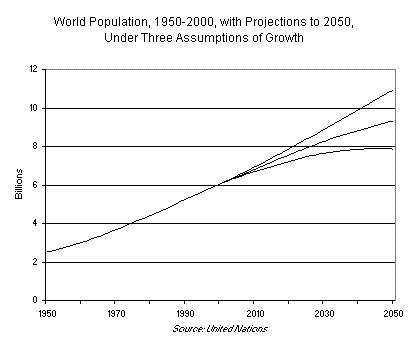"Oil wells go dry and coal seams run out, but for the first time since the Industrial Revolution began we are investing in energy sources that can last forever." –Lester R. Brown, Plan B 4.0: Mobilizing to Save Civilization.
Click here to view the most recent Population Indicator and Data
World population climbed to 6.2 billion in 2002, up almost 80 million or 1.3 percent from 2001. Population growth rates soared following World War II as health care improved and death rates fell. After peaking at 2.1 percent around 1970, annual world population growth fell to 1.3 percent by 1999. But even while global growth is slowing, there is a large disparity among the growth rates of individual nations, and human numbers overall continue to climb.
For at least 25 years, 20 European countries and Japan have had below replacement-level fertility rates (2.1 children per woman). By now a total of 44 countries have fertility levels that low. Without the projected gain of 2 million immigrants a year from developing countries, many industrial nations would shortly experience population declines.
In much of the developing world, however—home to nearly 5 billion people—populations are still growing rapidly. Even with anticipated declines in fertility rates, the developing world is projected to have 8.2 billion people by 2050. Six countries account for half of the world's annual addition: India (16 million), China (9 million), Pakistan (4 million), Nigeria (4 million), Bangladesh (3 million), and Indonesia (2 million).
The 48 countries classified as least developed have even more rapid population growth. If current trends continue, the combined populations of these nations will almost triple by mid-century—from 658 million to 1.8 billion. Among the 16 countries with extremely high fertility rates (seven children or more per woman) are Afghanistan, Angola, Burkina Faso, Burundi, Liberia, Mali, Niger, Somalia, Uganda, and Yemen.
Fertility rates in countries at the intermediate level, where women have between 2.1 and 5 children on average, are expected to drop below replacement level by 2050. This group includes India, Pakistan, South Korea, and Egypt, which were among the first to realize that rapid population growth makes it difficult to reach socioeconomic goals. With high population densities in their most fertile land areas, these countries recognized that fast-growing populations test the limits of both social services and nature's services.
Although the availability of effective contraception is a key to slowing population growth, some 350 million women worldwide still lack access to family planning. Filling the unmet need for family planning could reduce population growth by as much as a third, given the estimated number of unintended pregnancies in the developing world.
Fertility inversely correlates with levels of female education and employment. The more schooling women have, the fewer children they bear. Educating women and men about family planning services and making such services readily and discreetly available could profoundly reduce future world population size and poverty. Government-supported family planning programs increase access to reproductive and general health care. High per capita incomes, low child mortality, urbanization, and industrialization also can play a role in lowering fertility.
At the International Conference on Population and Development held in Cairo in 1994, parties agreed to fund a 20-year population and reproductive health program, with developing countries covering two thirds of the bill and donor countries paying the rest. The total yearly spending was expected to be $17 billion until 2000, and then climb to $22 billion by 2015. While developing countries have largely honored their commitment, donor countries have contributed only one third of their allotted share. The results of this shortfall are that training and services have not expanded as promised, which researchers calculate meant that between 1994 and 2000 some 122 million women became pregnant unintentionally. One third of them had abortions. In addition, an estimated 65,000 unintentionally pregnant women died in childbirth and 844,000 suffered chronic or permanent injury as a result of their pregnancies.
Epidemics like HIV/AIDS reduce population projections by increasing morbidity and mortality and also by lowering fertility. AIDS is altering the demographics of many countries, especially in Africa. In Botswana, 36 percent of the adult population is HIV-positive. There, life expectancy has fallen precipitously from 70 years to 36, and Botswana's total population in 2015 is projected to be 28 percent smaller than it would be in the absence of AIDS. In Zimbabwe, life expectancy has dropped to 43 years, and in South Africa, to 47.
Today nearly half the world's people live in cities, where concentrated populations facilitate disease transmission. Fortunately, high population densities also enable potentially efficient provision of services such as health care and education, if there is the political and community will.
Urban areas are expected to absorb almost all of the population growth of the next 30 years. After centuries of rural-to-urban migration, three fourths of people in the industrial world live in cities. Developing countries are following this same pattern. In 1950, 18 percent of people in the developing world were urban dwellers. This more than doubled to 40 percent in 2000, and is projected to reach 56 percent by 2030, when 60 percent of the world will live in cities.
Almost one third of the world today is under the age of 14. History's largest generation of young people is reaching or will soon reach reproductive age, intensifying population momentum. As medical advances allow people to live longer than ever before, the global population is also aging. Today more than 606 million people are older than 60—a number due to reach 2 billion by 2050.
The gap between the U.N. high-growth projections for 2050 of 10.9 billion and the low-end scenario of 7.9 billion is equal to about half the world's current population.
With water and land in limited supply worldwide, whether the world moves to the higher or lower number may have more influence on environmental and social sustainability than any other variable.
Copyright © 2002 Earth Policy Institute


 Print:
Print:  Email
Email

